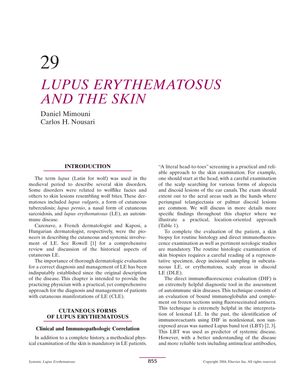Lupus Erythematosus and the Skin
January 2004
in “
Elsevier eBooks
”
Lupus Erythematosus chronic cutaneous lupus erythematosus subacute cutaneous lupus erythematosus acute systemic lupus erythematosus Lupus Tumidus Lupus Panniculitis Neonatal Lupus Erythematosus Discoid Lupus Erythematosus anti-Ro antibodies antinuclear antibodies autoantigen-specific T cells cutaneous lupus erythematosus ultraviolet light photoprotection systemic immunosuppressive therapy Chilblains lupus Raynaud's Phenomenon bullous lesions systemic corticosteroids steroid-sparing agents anti-TNF drugs thalidomide analogs LE CCLE SCLE ACLE LT LP NLE DLE anti-Ro ANA UV light RP steroids TNF inhibitors

TLDR Lupus affects the skin in various ways, and proper skin examination is crucial for diagnosis and treatment.
The document from 2004 provides a comprehensive overview of Lupus Erythematosus (LE) and its skin manifestations, including chronic cutaneous (CCLE), subacute cutaneous (SCLE), acute systemic (ACLE), and other forms such as Lupus Tumidus (LT), Lupus Panniculitis (LP), and Neonatal LE (NLE). It emphasizes the importance of a thorough dermatologic evaluation for diagnosis and management, noting the clinical and immunopathologic correlations in LE. Discoid Lupus Erythematosus (DLE) is identified as the most common form of CCLE, with a higher prevalence in African-Americans and a female to male ratio of 3:1. The document also discusses the immunopathology of DLE, the predictors of systemic disease in DLE patients, and the importance of serologic evaluations, including the presence of anti-Ro antibodies and antinuclear antibodies (ANA). It highlights the role of autoantigen-specific T cells in the pathogenesis of cutaneous lupus erythematosus (CLE), the effects of ultraviolet (UV) light, and the importance of photoprotection and systemic immunosuppressive therapy. Additionally, it covers various skin conditions associated with LE, such as Chilblains lupus, Raynaud's Phenomenon (RP), and bullous lesions, and discusses treatment options, including systemic corticosteroids, steroid-sparing agents, and the potential future role of anti-TNF drugs and thalidomide analogs.






